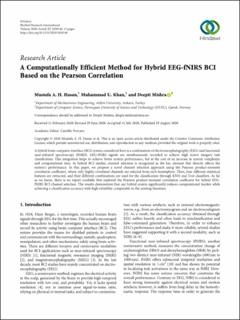| dc.contributor.author | Hasan, Mustafa A. H. | |
| dc.contributor.author | Khan, Muhammad U. | |
| dc.contributor.author | Mishra, Deepti | |
| dc.date.accessioned | 2022-05-04T11:33:49Z | |
| dc.date.available | 2022-05-04T11:33:49Z | |
| dc.date.created | 2020-09-27T20:25:08Z | |
| dc.date.issued | 2020 | |
| dc.identifier.citation | BioMed Research International. 2020, 2020 . | en_US |
| dc.identifier.issn | 2314-6133 | |
| dc.identifier.uri | https://hdl.handle.net/11250/2994162 | |
| dc.description.abstract | A hybrid brain computer interface (BCI) system considered here is a combination of electroencephalography (EEG) and functional near-infrared spectroscopy (fNIRS). EEG-fNIRS signals are simultaneously recorded to achieve high motor imagery task classification. This integration helps to achieve better system performance, but at the cost of an increase in system complexity and computational time. In hybrid BCI studies, channel selection is recognized as the key element that directly affects the system’s performance. In this paper, we propose a novel channel selection approach using the Pearson product-moment correlation coefficient, where only highly correlated channels are selected from each hemisphere. Then, four different statistical features are extracted, and their different combinations are used for the classification through KNN and Tree classifiers. As far as we know, there is no report available that explored the Pearson product-moment correlation coefficient for hybrid EEG-fNIRS BCI channel selection. The results demonstrate that our hybrid system significantly reduces computational burden while achieving a classification accuracy with high reliability comparable to the existing literature. | en_US |
| dc.language.iso | eng | en_US |
| dc.publisher | Hindawi Publishing Corporation | en_US |
| dc.rights | Navngivelse 4.0 Internasjonal | * |
| dc.rights.uri | http://creativecommons.org/licenses/by/4.0/deed.no | * |
| dc.title | A computationally efficient method for hybrid EEG-fNIRS BCI based on the Pearson correlation | en_US |
| dc.title.alternative | A computationally efficient method for hybrid EEG-fNIRS BCI based on the Pearson correlation | en_US |
| dc.type | Peer reviewed | en_US |
| dc.type | Journal article | en_US |
| dc.description.version | publishedVersion | en_US |
| dc.source.pagenumber | 13 | en_US |
| dc.source.volume | 2020 | en_US |
| dc.source.journal | BioMed Research International | en_US |
| dc.identifier.doi | 10.1155/2020/1838140 | |
| dc.identifier.cristin | 1833875 | |
| cristin.ispublished | true | |
| cristin.fulltext | original | |
| cristin.qualitycode | 1 | |

